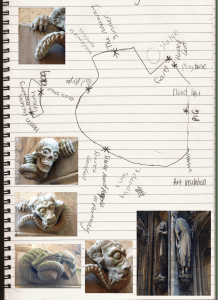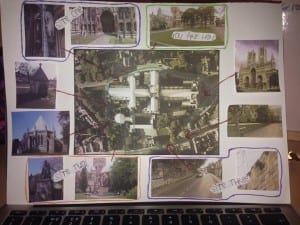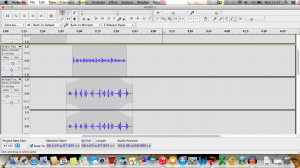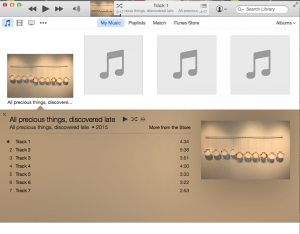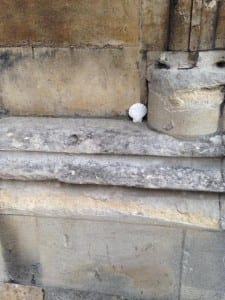Framing Statement
Over the course of this module my group and I were challenged to create a site specific performance within an allocated site. Our site was the area uphill in Lincoln, around the castle, the cathedral, and the surrounding areas. My group decided to centre our piece around the cathedral due to it’s rich culture and history.
Our final performance piece was titled ‘All precious things, discovered late’ which was a quote taken from Alfred Lord Tennyson’s poem The Arrival (1853). We wanted our piece to highlight the importance of appreciating life before it’s too late, and we felt this phrase captured this nicely. We began by researching the cathedral to gain a historical knowledge of the site. We soon discovered that there were several interpretations of the cathedral’s history. From this we established our performance idea of individuality and perceptions. To develop this we looked into the idea of the life cycle. The Shakespearian speech ‘all the worlds a stage’ was highly influential for us, as it helped us form the specific stages of life that would be placed in different areas around the site. The speech begins referring to an infant, and continues through the life cycle until second childishness and then death. This complete circle inspired us to tailor the audio to emphasis the inevitability of death, and also to highlight the importance of treasuring life’s special moments.
The Guardian’s Everyday Podcasts proved to be one of our main inspirations. Listening to how voice alone could create such powerful performances was something that really interested us. The relaxed tone of the piece and the natural honesty within Adrian Howells’ podcast was an aspect that we took on board for our own piece. We wanted to create an audio that felt more like a companion than an instructional voice, and so the tone of voice and choice of words within his piece proved extremely inspirational.
Our final piece consisted of an audio walk around the cathedral grounds. It was performed on Wednesday 6th May 2015 at 11:00am. It began with the audience arriving at the green opposite the judgment doors, where they would be introduced to the performance and given a scallop shell to hang around their neck, before embarking on the walk. The piece lasted approximately 20 minutes per-person, but varied depending on the pace at which each participant walked. The audio files were released on the Facebook event page prior to performance, and the audience were encouraged to download them to their own devices. By listening to the audio on individual devices it separated them, making the experience purely their own and not influenced by other members of the audience.
An Analysis of Process
My initial research
During our first class we conducted a silent mob outside the library, where we all simultaneously followed silent physical instructions. The reactions of passers-by fascinated me, and I thrived off the thought that we had broken the formality of their everyday journeys, potentially opening their eyes to what was around them. It was this sense of purpose behind the performance that I enjoyed, and I liked the idea of using performances for audience enlightenment. We took a walk around the cathedral quarters and the surrounding areas and I discovered a side to Lincoln I never knew. Wandering off the beaten track opened my eyes to Lincoln’s rich history that I knew existed, but had never witnessed. Phil Smith, from site specific performance company Wrights and Sites, stated that drifting through a city can allow you ‘to see for the first time things you already know’ (Smith, 2010, 119), and it was this sense of discovery that really interested me. I really enjoyed the visual impact of Christo and Jeanne-Claude’s Wrapped Trees (Javacheff and Denat, 1998). When the sun shone on the wrapped trees, they took a new form, something mystical that distorted the assumptions of the everyday. These performance art installations unsettle the repetitive journeys of the public, and encouraged them to pause and acknowledge their surroundings.
Performance style
I also looked into performances that involve a structured audience rather than passers-by. Platform Theatre Company created site specific theatre that aimed to educate the public of global concerns. They created performances such as Oil City (Platform, 2013) which took the audience on a journey around the site and ‘deep into the underbelly of London’s oil economy’ (Platform, 2013). During their piece the audience were taken to several influential places, and encouraged to interact with various actors about the controversy of Britain’s economy. The use of promenade theatre worked well as it encouraged the audience to build a personal relationship with the environment around them. I found this very inspiring. I really wanted the audience to gain a connection with whatever site I ultimately used. Although, at this point of the process I wasn’t sure what I wanted the audience to actually gain from this connection. However, I knew that in order for a message to be effectively understood, a good connection with the stimulus (the site) was vital.
Guided walks
During class we were asked to create an unconventional map around our site. Whist wandering around the cathedral, I stumbled across some devilish gargoyles and headless figures. My fascination with these statues took us on a completely different track, and we altered our map to mark where they were on the cathedral.
Phil Smith states that ‘certain things may begin to connect and once that starts happening, without obsessively pursuing a story, you can begin, collectively, to ‘compose’ your drift, allowing what has happened so far to determine your next choices’ (Smith, 2010, 199). The tangent we allowed ourselves to go on when creating the map meant that we developed something that was inspired purely from the site. I particularly liked the idea of a guide around the cathedral, creating stories about the gargoyles and headless statues, encouraging people to look beyond the typical tourist view. I wasn’t the only person who was interested in working around the cathedral so a group of four of us joined together to create our final performance group.
Ownership of a site
After reading Tim Etchells’ Certain Fragments (Etchells, 1999), the difference between seeing something and acknowledging its existence became apparent. Do we really appreciate what is standing right in front of us? Tim Etchells stated that ‘sight is nine-tenths of ownership’ (Etchells, 1999, 78). This phrase really made me think about what it means to own something. To own something literally is to have a connection with it, physically or emotionally, and from this you can develop appreciation. People see the cathedral in so many different ways; however it is normally from a touristic point of view. Through exposing local myths and stories about the site from the local residents, it encourages the audience to develop a deeper understanding of the cathedral, thus they can form a greater appreciation for it.
Speech and Audio
After discovering the devilish gargoyles, we were interested in recreating myths about the cathedral from the local residents. We wanted to recreate the telling of these stories though verbatim to give the piece a stronger connection to the site and its residents. Look Left Look Right Theatre Company’s performance The Caravan (Look Left Look Right, 2009) was ‘a half-hour verbatim show edited together from hours of transcribed conversations with […] victims of the UK floods in 2007’ (Moran, 2009). Verbatim worked well in this performance. It allowed the audience to experience the site in conjunction with ‘real life’ tales of its residents. The connection the audience gain from site specific verbatim performances was something we really wanted to achieve within our final piece.
I found listening to audio performances very influential for our final concept. Adrian Howells’ everyday moment (Howells, 2011) is an audio piece designed to be listened to in bed through headphones and with a hot drink. At first I felt slightly uneasy because his voice sounded like he was stood behind me, however as the podcast went on his voice became calming, almost reassuring. The honesty in the actor’s voice broke through my initial concerns and I ended up trusting his voice. The way he phrased what he was saying was incredibly cleaver. At the beginning, the words he used were general, however around about half way he began to use words like ‘us’ and ‘we’. By the time I had reached the end of the performance, I felt as if I knew him as a friend. Listening to these podcasts made me think about what can be defined as a performance, and how an audience doesn’t have to be present at a site for the piece to impact them.
I thought about the possibility of making mp3 downloads of the recordings that the audience could download to their own devices prior to the performance, putting the audience in control of their experience. As they are able to download the audio it to their own devices, they are able to keep the files, and if they wish to, redo the performance at their own time, leaving the audience with a token of their experience that they can reflect upon in the future.
Layers of perception
Focusing on speech in performance became something we were interested in so we went back to the site to see if we could overhear conversations about the cathedral. We overheard a father telling his child of the history of the building, although his youngest child lacked interest and continued to run around, shouting to see if his voice could echo. This made us think of the different perceptions that different ages can hold on one thing, such as the cathedral. This abundance of layers from one stimulus is similar to Forced Entertainment’s Night in this City (Etchells, 1995). They explored the ‘different histories written in an urban space – the official history, the personal, the mythical and the imaginary’ and ‘avoided facts in search of a different truth’ (Etchells, 1999, 80). Children have the most elaborate imagination and don’t posses any social filters. This gave us the idea of having an audio walk around the site with children giving their perspectives on objects such as the gargoyles.
Developing a performance
There were several points around the cathedral that we wanted to highlight on our walk. We knew we wanted to start and finish at the green opposite the judgment gates.
The statue of Alfred Lord Tennyson was a site that we really wanted to incorporate. His poem The Cradle Song (1809) speaks of birds and babies which linked with our theme of children’s perspectives. Our performance concept was about perception and imagination, and we realised that a poem has just as many layers as physical sites.
We researched into both adult’s and children’s imagination and gathered voice recordings from local shopkeepers and tourists about the cathedral.
We also got in touch with Westgate School, inquiring about recording children’s perceptions as well.
Aware that the audio alone wasn’t enough to create a performance, we developed creative tasks that the audience could do alongside the audio. We intended theses to stimulate a sense of childlike creativity, encouraging them to let their unconscious imagination come through.
From perspectives to a pilgrimage
Due to the lack of response from Westgate School, it forced us to scrap the concept of children’s perceptions, and we then focused on all ages. This linked back to our original idea of the layers of perception that surround the cathedral. The route we had picked out for our tour also influenced our process. It was an almost circular route, with the starting and finishing point at the same place. This made us think of a pilgrimage and the journeys of discovery the participants embark upon. Phil Couineau stated that ‘the object of a pilgrimage is not to rest and recreation […] To set out on a pilgrimage is to throw down a challenge to everyday life’ (Smith, 1998). Within Robert MacFarlane’s article he quotes Hillaire Belloc saying ‘the volume and depth and intensity of the world is something that only those on foot will ever experience.’ (MacFarlane, 2012). Hopefully at the end of the performance the audience may feel more aware of the site and themselves.
Structuring the audio
After our piece’s sudden change of direction, we began creating a script.
Whilst trialling the script in the site, a man approached us and asked us why the statues were headless? He mentioned that a lot of the smaller statues were also missing their heads. The man suggested stories of why they were headless, which inspired us to edit our audio to include several more recordings of perceptions as appose to one. To accompany the script we wanted to focus on the underlying message of the journey of life, so researched into poems and speeches that reflected this. We stumbled across the Shakespearian speech ‘all the words a stage’ which highlighted many stages of life and also emphasises the inevitability of a full circle to death. We decided to emphasise the progression of age we had my 86 year old granddad record it. To ensure this theme was evident, we allocated other sites between the Tennyson statue and the green to represent ages in between childhood and retirement. We looked at the stages of life spoken about in the speech and allocated a section of the performance to each stage.
- Birth (the judgement gates)
- Infant (the cradle song)
- Schoolboy (commenting on the school that is on route, and asking them to reflect on their schooling experience)
- Lover (confetti scattered on floor at Minster yard, and wedding bells in background of audio)
- Solider (castle square, look at the people marching in the square)
- Justice (walk through the archways, symbolising a change in time, and reflect upon journey)
- Elderly (all the words a stage speech)
To achieve this we needed to change the route of the performance, carrying straight on at Minster year and heading through Bailgate to castle square.
Orchestrated serendipity
Although we had certified our audio, we decided that our performance needed more substance. We researched into creating orchestrated serendipities, which are moments of planned coincidence. This led us to look into Proto-Type theatre company’s project Fortnight (Lees and Petralia, 2011). They held two week long pervasive media performances around cities, where they create ‘complex geographies of encounters –some which feel strange, some which feel theatrical, some which feel immensely personal’ (Hui, 2011, 18). Alan Kaprow’s Happenings were also something that influenced our process. He commented on his work stating that ‘the line between the Happening and daily life should be kept as fluid and perhaps instinct as possible’ (Kaprow, 1993, 62). This fluidity is something we wanted to include. We decided to place scallop shells subtly around the route, scatter confetti at minster yard, and hang a child’s rucksack at the Tennyson statue, trying to make them look as coincidental as possible.
Creating the audio
After 4 month of research, it was finally time to condense our ideas and record the audio. We recorded the audio for each track then I took them home and edited them in the audio editing software Audacity.
I looked back over the everyday podcasts, specifically Josie Long’s (Long, 2011). It was intended to be listened to whilst shopping in a supermarket. In the background there were sounds of tills bleeping and this was really effective at portraying the atmosphere of the piece. Therefore I tried the audio with subtle sound effects that correlated to the age we were representing.
Childhood
Elderly
Trial run
The feedback from our trial run suggested that we had over structured the audio. The way we had phrased the audio and Fleur’s tone of voice came across quite patronising, and suggestions had turned into orders. To gain a more conversation tone we recorded the following meeting on our phones. We then divided the audio into seven sections, and each took one or two home to transcript.
Recording real life conversations and creating a transcript linked with the concepts of verbatim theatre. Verbatim is when ‘the words of real people are recorded or transcribed by a dramatist during an interview or research project’ (Hammond and Steward, 2008). Although we were not transcribing the audio word for word, the creative process is extremely similar. Dramatists use verbatim to portray honesty in dialogue, and it was our intention to create a more casual, truthful audio.
The final audio
Our final collection of audios were exported off Audacity and made into mp3 files.
These were uploaded to SoudCloud and the link was published on our Facebook event page.
Performance evaluation
On the day of the performance the inevitable happened, it rained. However it didn’t dampen our spirts. We arrived at the site early to lay out scallops and other orchestrated serendipities.
The overall performance went well and we were happy to see the audience understanding the directions given on the audio and following the correct route. Personally, I believe that one of our strengths was the attention to detail of our audio. It took several attempts to get the phrasing of questions and the tone of voice right, as well as the correct local Lincolnshire knowledge. However, we believe that this detail was important in order to create an audio that would have maximum impact on the audience. However, I would prefer to have concentrated on our role in the performance more, possibly allocating more of a purpose to us, rather than simply being guide assistants and onlookers.
Due to the appalling weather, our audience consisted of only our examiners. However, this meant that all of our energy and concentration could be given to them, hopefully making their experience as good and as beneficial possible. They had downloaded the audio files prior to the performance and had brought them along on their own devices. At several moments during the performance they appeared to take time to reflect upon the performance, and hopefully their journey. Allison Hui stated that ‘works of art are meant to provoke affective responses – to move and push people to new understandings and new relations’ (Hui, 2011). This development of understanding from the audience was our overall intention, and I feel that we did all we could to encourage this.
If I could do this performance again I would prefer to have created more movement of orchestrated serendipities. We could have created more moments like the scattering of confetti, which coincidently complimented the audio and highlighted the stages of life more prominently.
Engaging with site specific theory has opened my eyes to the different possibilities of performance. Prior to this module I had only engaged with auditorium-based theatre, but I can now appreciate the large range of performance possibilities. Audio as performance was one particular aspect of theatre I had never heard of, but after engaging with audio podcasts and our own audio performance, I now understand the impact such intimate performances can have on an audience. I also now understand the concept of walking as performance. Walking is not only ‘directed movement from one place to another, but a wandering, an odyssey of sight and sound, a quest for knowledge and stimulation, a grand roaming expedition, and a living breathing work of art in its own right’ (Wrights and sites, 2006).
The cathedral has always been a site I was aware of, but only from a tourist’s perspective, but after engaging with the site throughout this process, I now see it in a completely different way. I understand not only the factual history of the building, but also the local history. The numerous stories and the imaginative interpretations attached to the cathedral allow me to appreciate the individuality that surrounds such a prominent well-known site.
Work Cited
Etchells, T. (1997) Nights in this City. [performance] Tim Etchells (dir.) Forced Entertainment. Sheffield, 8 April.
Etchells, T. (1999) Certain Fragments: Contemporary Performance and Forced Entertainment. London: Routledge.
Hammond, W. Steward, D. (eds.) (2008) Introduction in Verbatim Verbatim: Contemporary Documentary Theatre. London: London Oberon Books.
Howells, A. (2011) Everyday Moments 11: Audio drama for private performance. [podcast] 21 November. Available from http://www.theguardian.com/culture/audio/2011/nov/21/everyday-moments-podcast-adrian-howells [Accessed 17 February 2015].
Hui, A. (2011) Art as an everyday intervention: shifting times, places and mobilities in the pervasive media performance project “Fortnight”. The Association of American Geographers’ Conference, New York, 25 February 2012 [unpublished].
Javacheff, C, V. Denat, M, J. (1998) Wrapped Trees. [performance] Riehen, Switzerland: Fondation Beyelerand Bevower Park, 13 November.
Kaprow, A. (1993) Essays on the Blurring of Art and Life. California: University of California Press.
Langer, M. (2015) A Hidden Scallop. [online] Lincoln: Flickr. Available from https://www.flickr.com/photos/130320609@N04/ [Accessed 9 May 2015].
Lees, G. Petralia, P. (2011) Fortnight. [performance] Proto-Type Theatre. Bristol: 2nd – 15th May.
Long, J. (2011) Everyday Moments 8: audio drama for private performance. [podcast] 23 August. Available from http://www.theguardian.com/culture/audio/2011/aug/23/theatre-josie-long [Accessed 20 April 2015].
Look Left Look Right. (2009) The Caravan. [performance] Knightsbridge: Sloane Square, 10 February.
Platform. (2013) Oil City. [performance] London: around London’s business quarters, 10th -21st June.
Platform (2013) Oil City – Site Specific theatre by Platform 10th-21st June 2013. [online advertisement] Available from http://platformlondon.org/p-eventnew/oil-city-site-specific-theatre-by-platform-10th-21st-june-2013/ [Accessed 8th February 2015].
Smith, H. (1998) Forward in The Art of Pilgrimage: The Seeker’s Guide to Making Travel Sacred. California: Conari Press.
Smith, P. (2010) Mythogrography: A Guide to Walking Sideways. Devon: Axminster Triarchy Press.
MacFarlane, R. (2012) Rites of way: Behind the pilgrimage revival. [online] London: The Guardian. Available from http://www.theguardian.com/books/2012/jun/15/rites-of-way-pilgrimage-walks [Accessed 23 March 2014].
Moran, C. (2009) The Royal Court’s Caravan: a flood victim writes. [blog entry] 19 February. The Guardian. Available from http://www.theguardian.com/stage/theatreblog/2009/feb/19/royal-court-caravan-flood-victim [Accessed 15 February 2015].
Watson Bain, A. (1933) A poetry book for boys and girls. Cambridge: University Press.
Wrights and sites, (2006) ‘Dealing with the city’ [in press] A manifesto for a new walking culture. Available from http://www.mis-guide.com/ws/documents/dealing.html [Accessed on 27th April].

